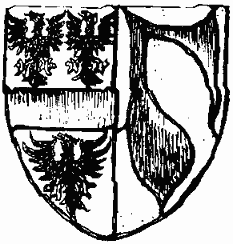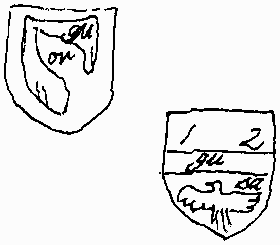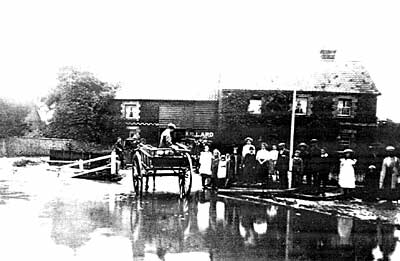The de Elmham and Hastings Shields

Sir William de Elmham was lord of the manor of Westhorpe and also Walsham. He died in 1403, leaving money to St. Mary’s church in Walsham. His shield was coloured silver with a red strip across the middle between three black eagles with their wings outspread. In heraldic terms this was ‘argent a fess gules between three eagles displayed sable’. These arms are in a north window of the nave at Wyverstone, where Sir William also had property. The glass is in poor condition after six centuries of weather damage, and most heraldic glass has been lost through natural causes rather than Puritan destruction. William Dowsing and his men were concerned with sacred images and left secular material intact.

At Wyverstone de Elmham’s arms are joined (heraldically ‘impaled’) with those of the Hastings family, for William was married to Elizabeth, daughter of the Norfolk knight Sir Hugh Hastings. At St. Mary’s Walsham the Hastings arms are also seen in the larger shield in the east window tracery. Heraldically speaking they are ‘or, a maunch gules’, in other words, gold with a lady’s sleeve in red (the wide trailing edge to the left, the gusset to the right). The shield was not always in the east window, having been reset in 1878, together with other medieval glass recovered from Walsham’s church windows. Describing St. Mary’s, a manuscript of about 1772 shows the Hastings shield next to arms now identified as de Elmham. The caption merely states that the shields were ‘Upon two Windows in ye N. Isle’. One of the few facts recorded of Sir William is that he left money to repair the north aisle, so it seems fitting that his shield and that of his wife’s family should have adorned the aisle windows.
Having survived into the late 18th century, these de Elmham arms must have been lost by 1878. Fortunately Lady Elizabeth’s family shield of about 1403 can still be seen, probably the oldest glass in St. Mary’s.
Brian Turner
Works consulted
A Dictionary of Suffolk Arms – J. Corder 1965; Guide to Heraldry in Suffolk Churches – G. D. Reynolds & P. MacLachlan eds. 1990
Curiously neither of these scholarly works mentions our Hastings shield. The 1772 manuscript ‘The History and Antiquities of the Hundred of Lothingland’ by John Ives, a Suffolk antiquary, is now in the Lewis Walpole Library, Yale University.
Wet Days in Walsham

In August 1912 a storm hit East Anglia causing particular damage in this area. The Bury and Norwich Post wrote: “ The word ‘ disaster’ will be writ large in the agricultural record of the year 1912. Anything more serious than the floods of the past week would be hard to imagine. The rainfall on Monday has had no parallel in modern times and following a succession of wet days since the start of August the result is floods that defy description. In Great Barton four and a half inches of rain fell in 16 hours, and in Walsham le Willows there have been unprecedented scenes. Roads have converted into rushing rivers, houses flooded and animals drowned.
In Walsham the highest and most disastrous floods ever known in the village occurred on Monday. About 2 o’clock in the afternoon matters began to assume a very serious aspect and the rapid rising of the river, which only last week was quite dry, was anxiously watched by numbers of people. About an hour later many persons had begun moving things to their upper rooms. Soon a number of cottages along the river route became flooded to some considerable depth and the premises of Messrs. J. F. Flatman & Son had water to the depth of 4 feet, but happily all the corn had been moved up to a granary in time.
The schools were flooded, also the Temperance Hall, the premises of Mr John Grainger, Messrs J Death, George Clamp, and W H Pollard. Many cottages were inundated including those of Mr A J Goodman, Mrs. Hunt, Mr. Wesley Jaggard, and Mr J Hubbard. Fortunately most of the occupants managed to get the bulk of their furniture to a higher floor which minimized the damage.
The flood reached its greatest height at 8 pm. when it entered the Congregational Chapel and also the houses of Mr E Robinson, Mrs Hutchinson, and Mrs I Clarke. At Mr P Rolfe’s, successor to Mr A J Cawston, some sheep narrowly escaped drowning. Some of the occupants down West Street took their pigs from the styes, which were becoming inundated, upstairs to the bedrooms for safety.
So great did the flood become that at one time it reached from the fire station by Mr. Harry Nunns to over a mile down the Finningham Road. At some parts all marks denoting roads or bridges were completely under water.
An attempt was made to get through at about 6 o’clock with a big horse and heavy cart belonging to Mr. Nunn but driven by Mr. Rust. The water however was level with the horses back and the flood lifted the horse off it’s feet.
The great surging volume of water, in some parts 40 yards wide and up to six feet deep, rushing into the lower part of the village constituted a sight never seen before and never to be forgotten.
Along the Finningham Road the farmhouse at ‘Sunnyside’ was flooded to a depth of 12 inches and regrettably in the farmyard a great number of pigs and fowl were drowned. All the adjacent cottages were flooded and the farm steward, Mr. Baker, found his house isolated, the family taking to the higher floor.
Some elderly persons living near the Baptist Chapel were very deeply flooded and were shut upstairs without food or firing. A recently erected shed was washed down and the footbridge carried out of position.
Hundreds of yards of road have been washed bare of soil and portions of brickwork on the Coach Road [The Avenue] and the Church bridge have been washed away, as was the fencing at the Girls’ School.
At about 7.30 p.m. the floods assumed such an aspect that Mr & Mrs Flatman, who had been shut in the bedroom, decided it would be safest to leave the house, which was accomplished by aid of a horse and cart, provided by Mr Nunn, and some ladders. Mr & Mrs Unglass, Mr & Mrs Hurrell, Mr G Pamment and their families also left their houses for the night. The water in front of Mr & Mrs Kerrison’s cottage in Coach Road was over three feet deep and so they were assisted out of their home by Mr Ward and Mr L Borley. [Tragically Leonard Borley was to die five years later in the rain and mud of Passchendaele]
Mr Robathan of ‘The Woodlands’, had a quantity of peas and beans washed away, and Mr Chapman of Hartshall Farm had some barley carried a half a mile. Along the river route in Walsham alone upwards of 40 houses were flooded.
A visit to the girls’ school and house after the flood had subsided revealed a sorry sight, the water having risen to a height of 4 feet tossed the furniture and other goods about in all directions and left the floor covered in mud and rubbish.”
In other reports this flood in 1912 was compared with one that had taken place over 30 years earlier in August 1879. The Bury Free Press of the day told the story:
‘On Sunday morning, the 3rd. inst. at about 2 am. a most fearful thunderstorm passed over the village of Walsham le Willows such as not one of the oldest inhabitants can remember.’
Many of them got up on hearing the thunder and seeing the lightening which was both sheet and forked and wonderfully continuous. The rain fell in torrents from the storm that seemed to come from the southeast but which after an hour appeared to divide, going westward and eastward, at which time the inhabitants began to be alarmed, particularly those living by the river. Their alarm was not without good reason as at about 4 am. the water was seen rushing strongly down river and many anxiously watched its progress. So rapidly did it rise that in less than an hour the schoolmistress Miss Kirby and the infant schoolmistress had to be taken from their house by the bedroom window, as the lower rooms were flooded.
The water also rushed through the houses of Henry Jaggard and William Clamp and by 6 o’clock the road from Mrs Hattons [Sunnyside Farm] to the Independent Chapel, a mile and a half, was impassable. The fields alongside the river were inundated and in the cottages the lower rooms were filled with water. The occupants blockaded in all directions but in spite of this the water forced through. The graves in the Independent Chapel yard were under water and the services in the Baptist Chapel could not be held.
A double tenement adjoining the chapel and near one of the bridges was washed down. At any little flood these cottages have been filled with water and so the poor people, warned by these experiences, had got their little furniture upstairs. However the water came with such a force that it undermined the foundation and at 7 o’clock the end of the house gave way and fell with a fearful crash. One poor woman, the wife of John Lummis, fell with it into the stream but a man named Baker, at some peril to himself, seized her and rescued her.
The other end of the house began to give way but assistance was at hand and the children of both families were rescued in safety. The water still rushed furiously upon the house and ultimately caused it to part in the centre and become a total wreck. As the flood somewhat subsided the furniture was got out the ruins, much damaged.
Another house in the High Street at the back of which the river runs was also much damaged. Just before 12 o’clock the back part fell. This house belongs to Henry Jaggard and is occupied by Mr Clamp, grocer. Furniture and goods floated from it down the river but with plenty of help the house was soon cleared and many things were recovered at the bridges. The estimate of Mr Clamp’s loss cannot as yet be ascertained.
The water got into Mrs Hatten’s drawing room and other houses on Cranmer Green were 5 feet under water. The occupants got upstairs and stayed there till evening; they were Robert Hubbard and family, Ellis and wife, James Sharman and large family, and the occupants of the houses washed away being the Lummis and Fordham families
The water at Miss Kirby’s school was about 5 feet deep and part of the back wall fell down. The next house, Mr. Clamp’s, seems to have sustained the most serious damage as many of his goods are lost or destroyed as the back of the house fell out. The water also entered the houses of E Pollard, H Hunt, G Smith, W Smith, J Read, and James Firman who suffered much.
During the day some hundreds of persons came to see the effects of the flood.
Mr Pearson at Grove Farm had a narrow escape from losing his pigs when Mr Hall rendered necessary assistance. Great praise is due to the inhabitants who helped less fortunate neighbours.
The overflowing river made the road impassable near Mr Sones and in West Street by Mr T Eastleas the water was over three feet deep and the residence of Mrs Martineau was blocked by the floodwater.”
The following Tuesday a meeting was held in the public hall chaired by H J Wilkinson Esq. who said that he had been in Walsham for 51 years and had never seen such a calamitous flood. The committee Dr Short, Rev. Norcock, Messrs J Miller, P Youngman, I A Clarke, T Golding and F Wainwright decided to set a fund to help the poor people affected.
A later report stated that the collection for the fund amounted to £9 12s 8d, the collection in the Independent Chapel raised £1 15s 0d and private donations came to £10 15s 0d which gave a total of £22 2s 8d. The committee voted that this money should be distributed according to the list of losses that have been valued by Mr I A Clarke and any surplus to be used for repairs to the school.
James Turner
Looking After Granny
When John Martineau built the cottages in the Causeway and elsewhere for his estate workers, he provided not only a substantial attractive house, a well, a pig sty, a bake-house, a wash-house, an apple tree, a walnut tree and a half acre plot of garden for growing vegetables, but, in some cases, also a widow’s room.
But for centuries people have been providing for their old age and caring for elderly relatives; the manor court rolls and probate wills are full of examples.
John and Alice Coggeshall lived in a house where Dages now stands, and in 1426 surrendered their house to Thomas Hereward of Bardwell on condition that he ‘make and build anew one house for a dwelling for the said John and Alice his wife to the end of their lives’ 1 Obviously for their old age,
The following year John Spilman surrendered a messuage and 80 acres of meadow and pasture to his son on condition that he ‘shall find or cause to be found sustenance of the said John, his father and Margaret his wife with all the victuals viz: in food, drink, cloth linen and wool for the body as well as for the bed, well and sufficient as is fitting to their present condition to the term of the lives of the said John and Margaret’. If John and Margaret preferred they could, alternatively, be given 45s pa., 2 quarters 4 bushels of wheat and 2 quarters 4 bushels of barley (for the staple bread and ale). They were also to have one room in the house for the term of their lives. 2 The Spilman tenement was on the site of the present Old Vicarage.
There used to be a cottage almost adjoining Four Ash Cottage known, in the medieval period, as Springalds. In 1444 Rose Hill, widow of John surrendered the house and 17 acres of land to their son John. In return she was to have a room at the east end of the main house with access to the fire. She was to be provided with 6 bushels of wheat, 1 quarter of barley, 1 bushel of oats, the custody of a cow and a quarter of bacon.3
In 1472 Agnes Bonde, widow of John surrendered her house in Church Street on condition that she have a room for the term of her life as long as she remained alive and unmarried, together with two cartloads of firewood and a sufficient part of the apples and pears and other fruit growing in the garden.4 Bondes tenement was on the site of The Limes with Bondes Wood to the north, so firewood was no problem.
While surveying the timber-framed buildings of Walsham recently, Leigh Alston discovered that the parlour of several houses had an extra exterior door. The parlour in these houses was often used as a granny flat. One of them, Church Farmhouse could be said to be ‘purpose-built’. The house was built c.1534 by William Hoxon and was therefore called Hoxons but a new parlour had been added about 1600. The records show that in 1601 the then tenant Nicholas Martin surrendered it to his son Walter; Nicholas and his wife were to have the use of the newly built parlour for life.5
Provision for widows in wills was common as one would expect but one, that of Elizabeth Elmham, lady of the manors of Westhorpe and Walsham shows generosity to other widows. In her will of 14196 she left 100 marks (one mark was worth 13s 4d) ‘to poor widows and for finding poor clerks to school and for the marriage of poor women and other poor people who are in distress in the counties of Suffolk and Norfolk….’
Millers Close, built c. 1960, now provides sheltered housing for six elderly people and another six have wardened accommodation in Town House Road. There is a communal room at Millers Close where a ‘drop-in centre’ is held each Wednesday with lunch and coffee provided. In addition, the Willow Club, held in the communal room once a fortnight, has been running for 40 years, providing talks, outings, entertainment and help.

